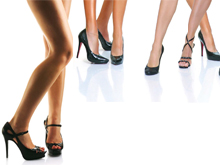 |
To begin with, high heeled shoes are certainly not advisable on a constant basis. That’s because high heels in shoes alter the ‘line of weight bearing’ of the body – it will exert abnormal pressures over all of the areas forming the mechanical axis of the body. |
This includes the forefoot (especially the toe break area), the midfoot, the ankles, the calves, back of the knees, the hips, and the lower and middle back. This altered weight transmission leads to increasing severity of some characteristic foot and back problems.
The Heel Effect
High heels affect your feet first. The first three effects listed here are because of a small toe box, which narrows the space between the toes.
- Deformities of toes can happen where the great toe can painfully bend inwards (hallux valgus) or give you hammer toes (bent or claw toes).
- You can also get chronic midfoot strains, and stress fractures of the midfoot bones
- You could get pain, tingling and numbness along the sides of the 3rd and 4th toes – a condition called Morton’s metatarsalgia
- Pressure sores or bunions, corns and callousities (at the balls of the feet, and upper surface of toes) could also spring up.
- You could get calf cramps (sustained tense contracted position of the calf muscles) too.
- Accelerated knee joint wear and tear (increased stresses on the front of the knee).
- Unsteady gait, and increased incidence of falls and thereby injuries (strains, sprains, fractures).
- Watch out for chronic lower back pain (due to prolonged lumbar muscle spasms, exaggerated lumbar lordosis, and fixed pelvic tilt).
What Do High Heels Do?
- High heels cause a compensatory change (temporary at first; permanent later) in the lower spine, with a decrease in the lumbar flexion angle (to prevent one from falling forward).
- This excessive back arching means that the main muscle of the back, the erector spinae, is working strongly, and continuously. Over-activity of these muscles leads to an injured or torn ligament in the back, and pain.
- Initially, there are repetitive strains and muscle pulls, and eventually, chronic strain and fatigue sets in.
- With continuing over-activity, the lower spinal joints undergo degenerative changes, and early onset of lumbar spondylosis, arthritis of the facet joints in vertebrae, and occasionally spondylitis, all non-reversible.
- Further, as one ages, discs shrink in size, with reduced ligament and joint function, that makes spinal bones move more than they should.
- Secondary changes also settle in, and worsen the pain.
|
Dr. Rajiv Thukral is Consultant Orthopaedics at Apollo Hospitals, Noida
|
|